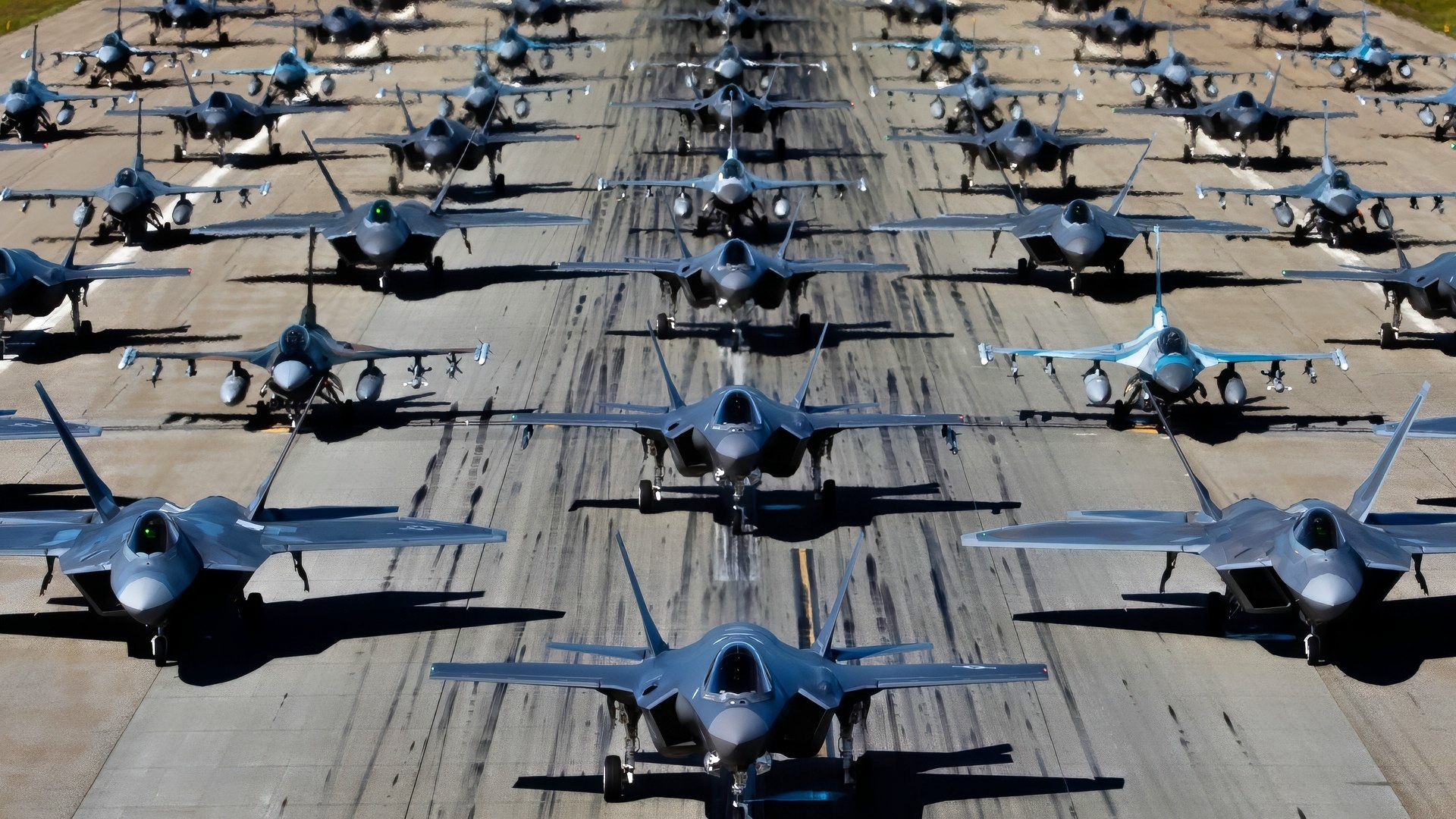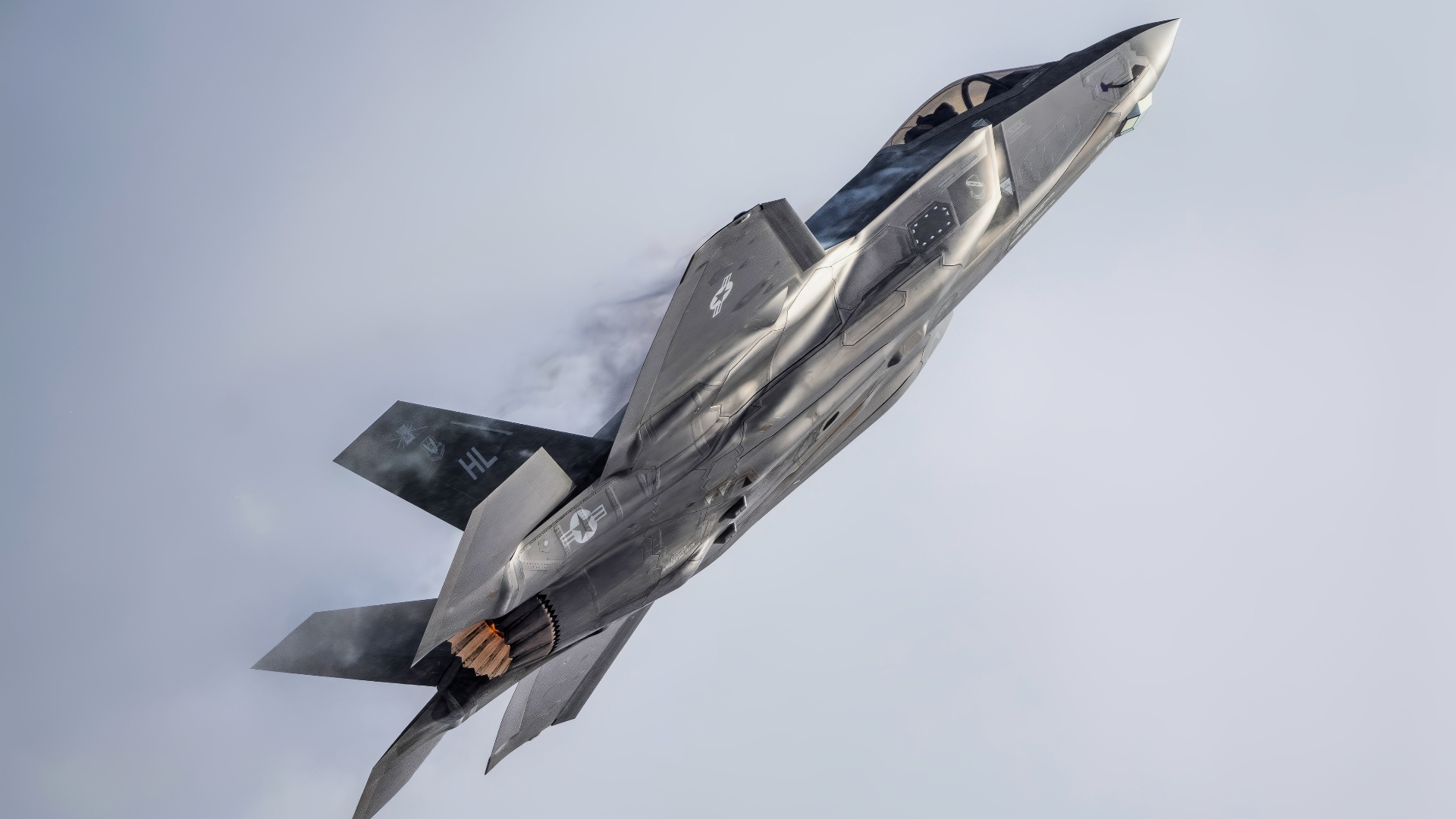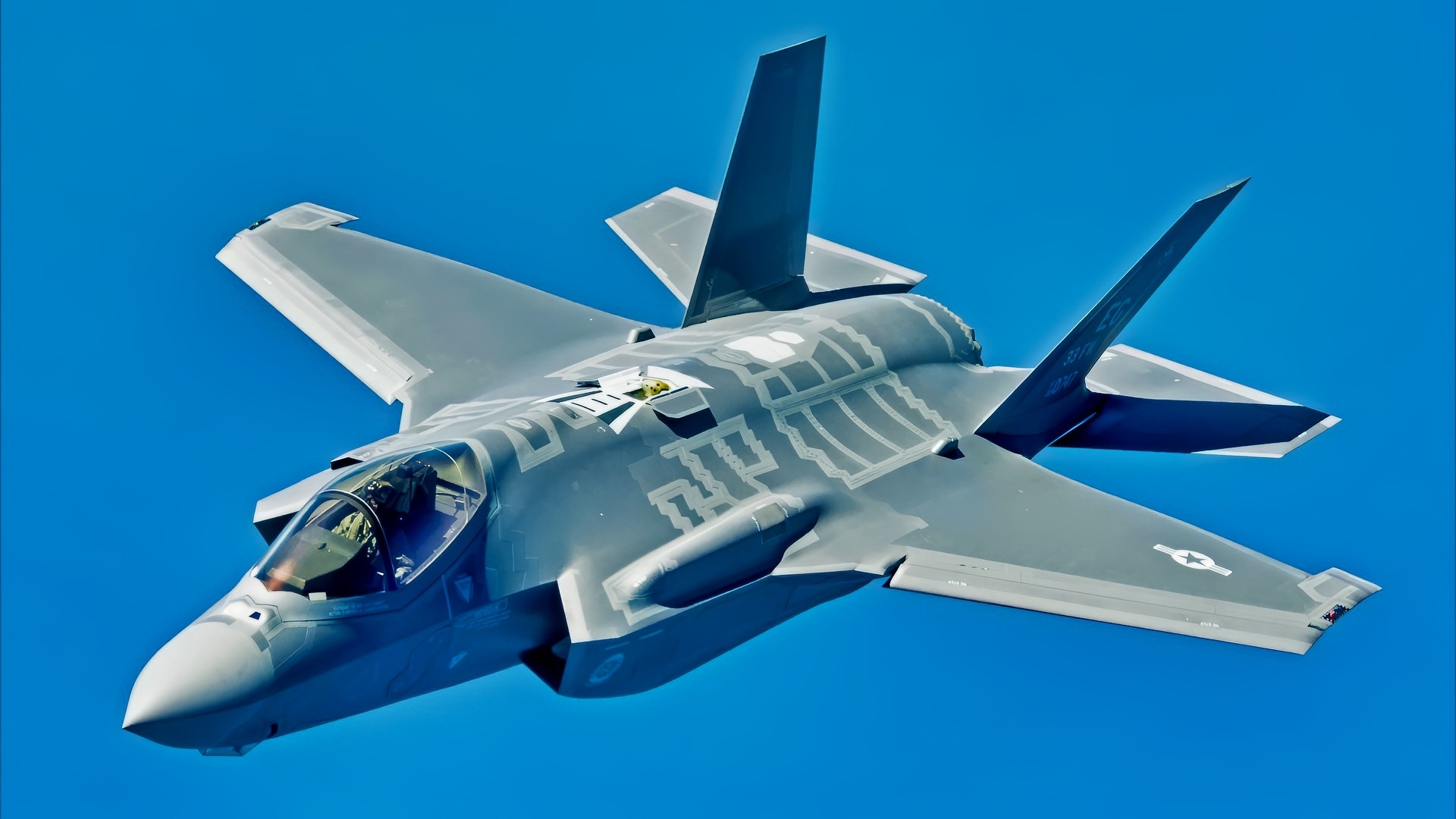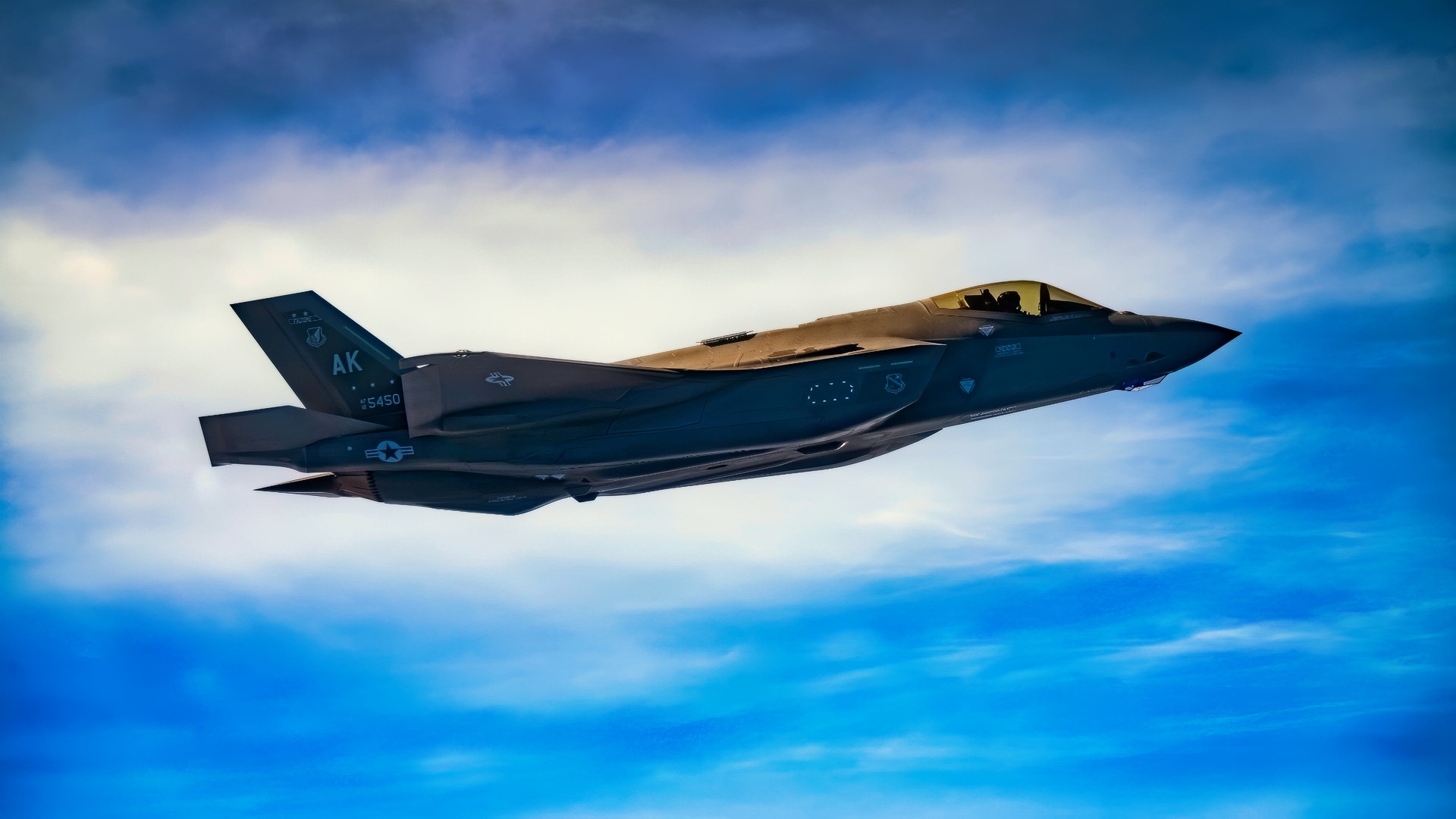Key Points and Summary – NATO’s annual nuclear deterrence exercise, “Steadfast Noon,” is underway with 70 aircraft from 14 nations.
-The routine drill, which uses no live weapons, has two significant firsts this year:
-F-35 stealth jets are leading the “strike package” for the first time, and Sweden is participating for the first time since joining the alliance.
-Taking place amid heightened tensions with Russia, the week-long exercise is designed to test the credibility and effectiveness of the alliance’s nuclear capabilities.
-NATO officials have emphasized that the exercise is a defensive and responsible demonstration of readiness.
Steadfast Noon: F-35 Fighters Lead Exercise for the First Time
On Monday, NATO announced that Steadfast Noon, its annual nuclear deterrence exercise, had begun.

The 354th Fighter Wing conducts a 75-fighter jet formation at Eielson Air Force Base, Alaska, Aug. 12, 2022, in honor of the U.S. Air Force’s 75th Anniversary. This capabilities demonstration included F-35A Lightning II, F-16 Fighting Falcon and F-22 Raptor aircraft from across Pacific Air Forces. (U.S. Air Force photo by Senior Airman Gary Hilton)

A U.S. Air Force F-35A Lightning II assigned to the F-35A Lightning II Demonstration Team performs a practice airshow performance at Hill Air Force Base, Utah, Jan. 11, 2023. The F-35 Demo Team performs rehearsal flights regularly to maintain flying certifications and to uphold and maintain their mission and Air Force recruiting standards. (U.S. Air Force photo by Staff Sgt. Kaitlyn Ergish)
“The exercise is a long-planned, routine training activity and part of NATO’s broader efforts to maintain readiness and ensure transparency around its nuclear posture,” NATO said in its announcement, possibly to avoid the implication that the exercise is linked to current tensions with Russia.
“It is not linked to any current world events, and no live weapons are used,” NATO’s announcement says.
The exercises include 70 aircraft from 14 nations, with the participation of different NATO nations rotating each year. Most of them are based at Volkel Air Base in the Netherlands, while others are located at Brogel Air Base in Belgium and Royal Air Force Lakenheath in the UK.
The Steadfast Noon exercise continues through October 24. It will not use any live nuclear weapons, NATO has made clear, although it does involve the planes that can deliver them.
“We need to do this because it helps us make sure that our nuclear deterrent remains as credible, safe, secure, and effective as possible,” NATO Secretary General Mark Rutte said in this week’s announcement.
The exercise is about “promoting transparency when and where appropriate, so that our Allied populations and the wider world have a good understanding of what we are doing,” Jim Stokes, NATO’s Director of Nuclear Policy, said in the NATO release.
Here Come the F-35s
According to a FlightGlobal report on Friday, this year’s Steadfast Noon exercise includes a first for a NATO nuclear deterrence exercise: F-35 jets taking the lead.
The F-35As, from the Royal Netherlands Air Force (RNLAF), will be “leading the Steadfast Noon strike package for the time in the alliance’s 76-year history.”

U.S. Air Force F-35A Lightning II Joint Strike Fighter pilots from the 58th Fighter Squadron, 33rd Fighter Wing, Eglin AFB, Fla., navigate their aircraft toward an Air Force Reserve KC-135 Stratotanker from the 336th Air Refueling Squadron, March ARB, Calif., May 16, 2013, off the coast of northwest Florida. The 33rd Fighter Wing is a joint graduate flying and maintenance training wing that trains Air Force, Marine, Navy and international partner operators and maintainers of the F-35 Lightning II. (U.S. Air Force photo by Master Sgt. John R. Nimmo, Sr./RELEASED)

A U.S. Air Force F-35A Lightning assigned to the 356th Fighter Squadron, Eielson Air Force Base, Alaska, flies alongside of a U.S. Air Force KC-46A Pegasus assigned to the 77th Aerial Refueling Squadron, Seymour Johnson AFB, North Carolina, over the Pacific Ocean while enroute to the Singapore Airshow 2022, Feb. 11, 2022. The Singapore Airshow is the largest defense exhibition and biennial international tradeshow in the Pacific attracting thousands of participants from 50 countries. The U.S. Military is participating in Singapore Airshow 2022 by providing aerial demonstrations and static aircraft to demonstrate commitment and build upon partnerships with Singapore. (U.S. Air Force photo by Master Sgt. Richard P. Ebensberger)
The chief of NATO’s nuclear operations, US Air Force (USAF) Colonel Daniel Bunch, said that the F-35As will operate from Vokul Air Base.
“This is the first year where the F-35 is going to be leading this mission,” Bunch said, per FlightGlobal. Also participating will be the German Panavia Tornado strike aircraft. Both, in the exercise, will “carry” the B-61 air-dropped nuclear bomb, but it’s the F-35 that will carry out the “strike” role.
“Steadfast Noon is a nuclear deterrence exercise, but no nuclear weapons will be used or exercised with during this exercise,” Bunch said in the story. “It is about demonstrating the capabilities of the aircraft and the people maintaining them.”
Defense News reported, shortly before the exercise started, that this year’s Steadfast Noon would feature “the largest number of participating aircraft in recent years,” the exercise centered around the North Sea.
“The United States will participate with four F-35s jets in the dual-capable aircraft role for the first time, with that role previously performed by the F-15E Strike Eagle,” Defense News reported, citing a briefing held before the start of the exercise.
Sweden Takes Part
In another first, as reported by Breaking Defense, Sweden is sending JAS 39 Gripens to the Steadfast Noon exercises, which also marks Sweden’s first participation in Steadfast Noon, after it formally joined NATO in March of 2024. That represented a shift, per that report, after Sweden “avoided military alliance for 200 years and has avoided nuclear entanglements entirely.”
“In an increasingly uncertain world, NATO needs a credible nuclear capability to prevent attacks against the Alliance. Steadfast Noon contributes to ensuring this,” Prime Minister Ulf Kristersson said in a statement Friday, as reported by Breaking Defense.

A Swedish Air Force JAS 39 Gripen participating in NATO exercise Ramstein Flag 24 flies over the west coast of Greece, Oct. 4, 2024. Over 130 fighter and enabler aircraft from Greece, Canada, France, Hungary, Italy, Poland, Portugal, Romania, Spain, Sweden, United Kingdom and United States are training side by side to improve tactics and foster more robust integration, demonstrating NATO’s resolve, commitment and ability to deter potential adversaries and defend the Alliance. (U.S. Air Force photo by Tech. Sgt. Emili Koonce)
“By participating with conventional Gripen combat aircraft in Steadfast Noon, Sweden contributes to ensuring that NATO’s nuclear deterrence remains credible, robust, and effective,” Defense Minister Pål Jonson said in a statement.
Finland is also participating again, after making its Steadfast Noon debut last year, after becoming a NATO member in 2023.
Per deutschland.de, Germany’s air force has deployed Tornados to the base to participate in the exercise.
“The exercise is intended to send a clear signal to Moscow that, if the worst comes to the worst, the alliance is prepared to defend itself with nuclear weapons,” the site paraphrased Rutte as stating in his pre-exercise video message.
Which Planes Are Capable
Per the report, the B-2 bombers and F-35A are “the only stealth aircraft in the NATO inventory capable of delivering nuclear weapons.” However, “dual-capable” fighters from Belgium, Germany, Greece, Italy, the Netherlands, and Turkey can carry American nuclear bombs that are stored in Europe.

Right Up Front B-2 Bomber USAF Museum. Image by Harry J. Kazianis/National Security Journal.
France, per FlightGlobal, has its own nuclear weapons, which it has “traditionally kept its nuclear forces outside the NATO command structure.”
In addition to the planes, per the report, the U.S. the U.K., and France each have their own submarines that carry nuclear weapons, while the U.S. has both land-based ICBMs and its own bombers that are based in North America rather than Europe.
A Stressful Time
As noted in the Defense News story, this year’s exercise comes at “ a time of heightened nuclear tension.”
Russia’s Deputy Foreign Minister Sergey Vershinin, earlier this year, hinted at a high risk of confrontation between nuclear powers, amid the continuing war in Ukraine, and multiple instances of Russian drones landing in NATO airspace.
“It’s a yearly training and it is regular, and we need to do this because it helps us to make sure that our nuclear deterrent remains as credible and as safe and as secure and as effective as possible,” Rutte said on the eve of the exercise.
“It also sends a clear signal to any potential adversary that we will and can protect and defend all allies against all threats.”
Stokes, per Defense News, said before the exercise that the alliance is stepping up communications around this year’s Steadfast Noon.
“We want to make sure that folks understand that we’re a responsible nuclear alliance,” Stokes said, per the report. “We are not acting aggressively, we are not using irresponsible nuclear rhetoric. We’re also not doing anything other than ensuring that we are prepared to defend ourselves if we need to, because NATO is a defensive alliance.”
About the Author: Stephen Silver
Stephen Silver is an award-winning journalist, essayist, and film critic, and contributor to the Philadelphia Inquirer, the Jewish Telegraphic Agency, Broad Street Review, and Splice Today. The co-founder of the Philadelphia Film Critics Circle, Stephen lives in suburban Philadelphia with his wife and two sons. For over a decade, Stephen has authored thousands of articles that focus on politics, national security, technology, and the economy. Follow him on X (formerly Twitter) at @StephenSilver, and subscribe to his Substack newsletter.
More Military
The First 48 Hours of a War With China ‘Could Be Ugly’
Russia Tried to Build Their Very Own F-22 Raptor. Calling It a Disaster Would Be a Gift
The Royal Navy’s Queen Elizabeth-Class Aircraft Carriers Simply Summed Up in 4 Words










